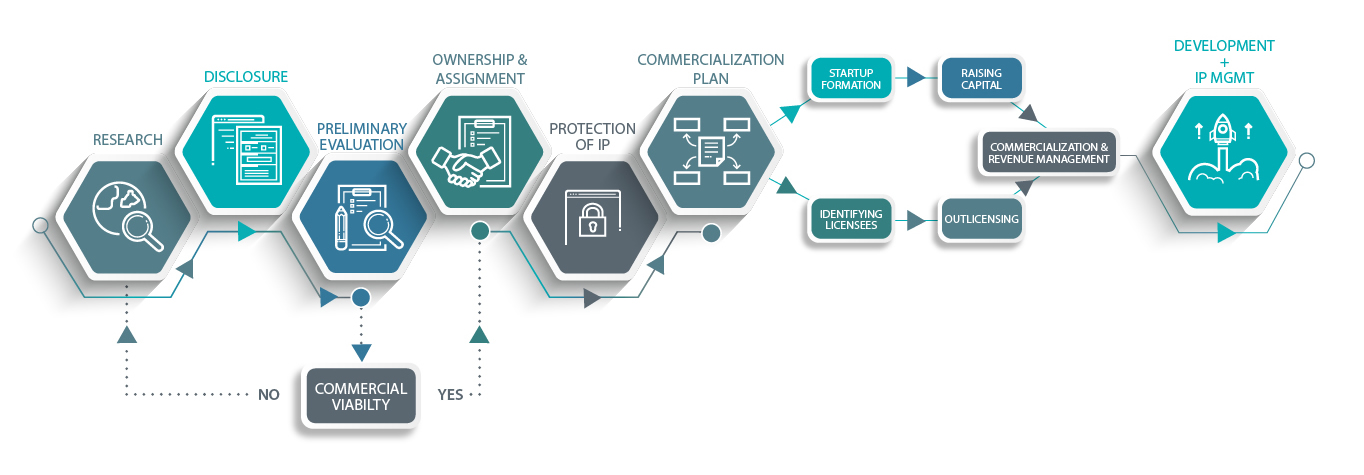Process of Technology Transfer
The entire process of invention translation from the research lab to a commercial product is complex and lengthy. It consists of multiple distinct stages that take several years to complete. Here you can find an overview of the process of technology transfer and a brief description of each of the steps involved in this process.
- Research and Discovery – The first step of commercialization of any university invention is the research and discovery done by the inventor(s). Without this, there would be no new ideas or technologies to commercialize. This initial essential step is conducted by faculty, staff and students in the research labs across a wide range of disciplines.
- Invention Disclosure – When faculty, staff, or students think that their research has resulted in an invention that is novel and has possible commercial value they should submit an invention and disclosure form (IDF) to the Office of Technology Transfer (OTT). This is a confidential internal document for declaring an invention and allows the OTT to initiate the process of technology transfer. The OTT cannot initiate evaluation of any invention and the subsequent necessary steps associated with the technology transfer process until a formal IDF is received from the inventor(s). However, it is important for inventor(s) to remember that the IDF is only an internal document and does not offer any legal protection for the intellectual property (IP).
- Evaluation by OTT – The OTT staff will conduct evaluation of the invention using the information disclosed by the inventor(s) through the IDF. We will look into novelty, patentability, competitive advantage over similar existing technologies, future commercial value and various other factors to determine whether the invention is suitable for NSU to pursue IP protection and further development.
- Protection of IP – Once the invention has gone through initial evaluation and we have decided to invest NSU’s resources to protect its IP, we will start working with outside patent counsel to file the appropriate documents. The first step is to file a provisional US application in the US Patent and Trademark Office. This may be followed by a Patent Cooperation Treaty (PCT) application within 12 months of the provisional application. The inventor(s) will be consulted and informed about all IP related steps.
- Commercialization – After the protection of IP, the OTT staff will create a plan for marketing and commercializing the technology. There are multiple avenues for commercialization of an invention. We will work with external corporate collaborators and NSU inventor(s) to determine the commercialization path ideal for each technology. There are multiple avenues for commercialization and whichever path is most appropriate will depend on multiple factors such as the invention’s stage of development, future plans of the inventor(s) and the technology’s commercial demand. The final decision of the path to commercialization and deciding on the corporate collaborators will be done only after consulting with the inventor(s).
- Revenue Management – Once the external corporate collaborator has started generating revenue through commercialization of the technology acquired from NSU, a predetermined portion of it will be shared with NSU. Unless a different revenue sharing plan is agreed upon by all the parties in a written agreement, the inventor(s) and the University each receive 50% of the “net income”. The details of revenue distribution are in the “Employee Policy Manual,” which can be found in the "Important Documents" section on this OTT webpage.
